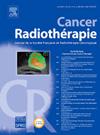Interpreting the patterns of local failure following postoperative volumetric-modulated arctherapy in oral cavity and oropharynx cancers: Impact of the different methods of analysis
IF 1.4
4区 医学
Q4 ONCOLOGY
引用次数: 0
Abstract
Purpose
Intensity-modulated radiation therapy or volumetric-modulated arctherapy is nowadays the recommended radiation technique for the treatment of head and neck cancers. However, by providing a significant dose gradient between target volumes and organs at risk, there is a risk of target missing and thus recurrence in case of inadequate delineation. It is therefore necessary to determine the origin of these recurrences to improve clinical practice. Over the past years, different methods have been described for the analysis of recurrences. Using the patterns of failure of patients with oral cavity and oropharynx carcinoma, treated with postoperative volumetric-modulated arctherapy in our institution, the purpose of this work was to analyse the sites of local recurrences and to evaluate the disparity in the classification of recurrences when different methods were used.
Material and methods
Between 2011 and 2019, 167 patients who underwent postoperative volumetric-modulated arctherapy for oral cavity or oropharyngeal cancers were included (60 and 40 % respectively). Two or three dose levels were prescribed (54 Gy, 59.4/60 Gy ± 66 Gy). Local recurrence occurred in 17 patients (10.2 %). We assessed the patterns of local recurrences according to four methods: 1/ volume-based method using the volume overlap between the recurrence volume and initial target volumes; 2/ volume-based method of overlap between the recurrence volume and the 95 % treatment isodose; 3/ point-based method using the position of the barycentre of the recurrence volume; 4/ combined centroid method classifying recurrences according to both the initial target volumes and dose distribution. Each case was reviewed to make a clinical judgment on these classifications and assessed them as “appropriate”, “possible”, or “inappropriate”.
Results
For the volume-based method using overlap between the recurrence volume and the initial clinical target volume, this classification was clinically judged as inappropriate in 11 out of 17 cases (65 %). For the volume-based method using overlap between the recurrence volume and the 95 % prescribed isodose, this classification was clinically judged as appropriate in 15 out of 17 cases (88 %). For the point-based method, this classification was clinically judged as appropriate in 14 out of 17 cases (82 %). Thirteen out of 17 local recurrences had the same classification between this point-based method and the volume-based method of overlap between the recurrence volume and the 95 % prescribed isodose. For the combined centroid method, among 17 local recurrences nine were classified as type A, two as type B, two as type C, three as type D and one as type E. This classification was clinically judged as appropriate in 15 out of 17 cases (88 %). Only five out of 17 of the local recurrences were classified the same way according to the four different methods (29 %).
Conclusion
Recurrences that are “marginal” or “outfield” represent a major challenge for intensity-modulated radiation therapy/volumetric-modulated arctherapy quality assurance and improvement of delineation recommendations. To date, there are no published methods that give complete satisfaction.
解读口腔癌和口咽癌术后体积调控动脉治疗局部失败的模式:不同分析方法的影响。
目的:目前,调强放射治疗或容积调强放射治疗是治疗头颈部癌症的推荐放射技术。然而,由于靶体积和危险器官之间存在明显的剂量梯度,因此在靶区划分不清的情况下,存在漏靶和复发的风险。因此,有必要确定这些复发的原因,以改进临床实践。在过去的几年中,已经有不同的方法用于分析复发。本研究利用本院口腔癌和口咽癌患者术后接受体积调制动脉治疗失败的模式,分析局部复发的部位,并评估使用不同方法对复发进行分类时的差异:2011年至2019年期间,167名口腔癌或口咽癌术后患者接受了体积调制动脉放射治疗(分别占60%和40%)。处方剂量为两种或三种(54Gy、59.4/60Gy±66Gy)。17名患者(10.2%)出现局部复发。我们根据四种方法评估了局部复发的模式:1/基于体积的方法,利用复发体积与初始目标体积之间的体积重叠;2/基于体积的方法,利用复发体积与95%治疗等剂量之间的重叠;3/基于点的方法,利用复发体积的原发中心位置;4/综合中心法,根据初始目标体积和剂量分布对复发进行分类。对每个病例进行复查,对这些分类进行临床判断,并将其评估为 "适当"、"可能 "或 "不适当":结果:对于使用复发体积与初始临床目标体积重叠的体积分类法,17 例病例中有 11 例(65%)临床判断为不恰当。对于使用复发体积与 95% 处方等剂量之间重叠的体积法,17 个病例中有 15 个病例(88%)临床判定该分类为适当。对于以点为基础的方法,临床判断 17 例中有 14 例(82%)适合这种分类。在 17 个局部复发病例中,有 13 个病例的复发点分类与复发体积与 95% 规定等剂量重叠的体积分类相同。在综合中心点法中,17 个局部复发病例中有 9 个被划分为 A 型,2 个为 B 型,2 个为 C 型,3 个为 D 型,1 个为 E 型。在 17 例局部复发病例中,只有 5 例(29%)按照四种不同的方法进行了相同的分类:结论:"边缘 "或 "外野 "复发是强度调控放射治疗/容积调控热疗质量保证和改进划界建议的一大挑战。迄今为止,还没有公开发表的方法能让人完全满意。
本文章由计算机程序翻译,如有差异,请以英文原文为准。
求助全文
约1分钟内获得全文
求助全文
来源期刊

Cancer Radiotherapie
医学-核医学
CiteScore
2.20
自引率
23.10%
发文量
129
审稿时长
63 days
期刊介绍:
Cancer/radiothérapie se veut d''abord et avant tout un organe francophone de publication des travaux de recherche en radiothérapie. La revue a pour objectif de diffuser les informations majeures sur les travaux de recherche en cancérologie et tout ce qui touche de près ou de loin au traitement du cancer par les radiations : technologie, radiophysique, radiobiologie et radiothérapie clinique.
 求助内容:
求助内容: 应助结果提醒方式:
应助结果提醒方式:


